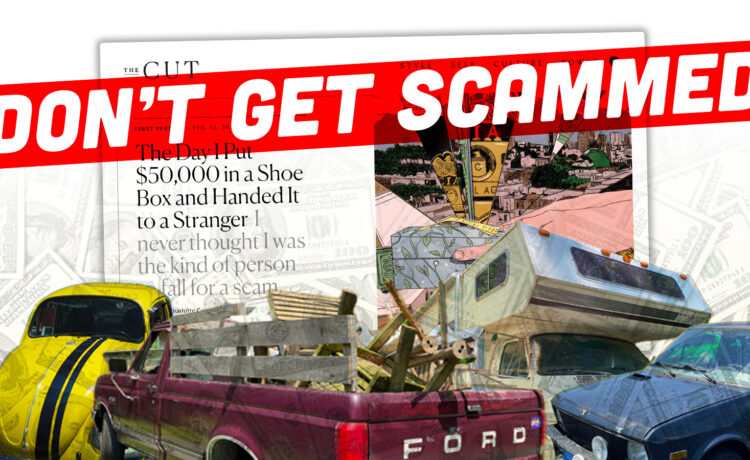I’m not sure if you’ve spent any time this week on the vast network of computers and EKG machines and cash registers that we collectively call “the internet,” but yesterday and today everyone seemed to be talking about an article on the website The Cut written by a financial advice columnist who got scammed out of $50,000. I’m pretty sure the article was such a popular topic of discussion because it contained so much rich, creamery schadenfreude packaged in such an appetizing way: a smug, wealthy person who literally writes about “financial literacy” for a living, getting convinced by the most inane, transparent of scams into cramming $50,000 into a shoebox and throwing it into the window of a Mercedes-Benz SUV. It’s a hell of a ride, but, more importantly, it lays bare the one bit of truly worthy financial advice: The only smart way to keep your money safe is clearly to transform that wealth into many non-running cars that you can then litter about your property or along a nearby street.
The financial-advice columnist, Charlotte Cowles, definitely went through something shitty: She got an unsolicited call from someone claiming to be Amazon, talking about some unexpected large purchases, and from there was transferred to people claiming to be from the Federal Trade Commission and then the CIA. They knew her Social Security number and information about her family, and talked her into pulling $50,000 from savings and giving it to someone purporting to be an undercover CIA agent.
![]()

In reading her account, the ruse seems glaringly obvious, and the insistence that she avoid telling her husband, lawyer, police or anyone should have made any remotely-familiar-with-modern-society person stop in their tracks and, you know, not give any money to these people. But that’s not how it played out.
To her credit, writing about it is a good thing to do, as it can help inform people of the dangers of such scams. She could have kept quiet, kept her reputation as a non-mark financial advice columnist intact, but she didn’t.
So, that was good of her, I suppose. I can respect that. Still, I can’t shake the feeling that my long-dead grandma, who spoke either six languages or none, depending on how strict you are with what defines a “language,” and who I think was illiterate, could have detected that something in the ham-fisted performance of these scammers was “off.”
[Editor’s Note: I want to make it clear that, though we’re poking fun at this columnist, we are empathetic. We don’t want her or anyone who is the victim of a scam to feel shame, especially given that this columnist mentions she had to attend therapy as a result of this incident. We wish her all the best; with that said, we’re just poking a bit of fun, here. And again, we respect her for telling this story and for raising awareness to this issue in a way that no public service announcement or less-compelling news story ever could. People are talking about scams right now, so Cowles’ story could really prevent someone from going through something similar. -DT].

The scam was the sort of thing that nobody I know would have fallen for, because no one I know would bother to take a phone call from “Amazon.” Amazon isn’t calling you! But, Cowles did think Amazon was calling her, and then the FTC, and then the freaking CIA, and she seems to have bought it all. If she was transferred to Sasquatch to confirm her bank account and routing numbers I have no reason to believe she wouldn’t have taken that call, too.
Cowles makes it very easy to be less than totally sympathetic because she notes how she’s an unlikely scam victim by writing this:
“Scam victims tend to be single, lonely, and economically insecure with low financial literacy. I am none of those things. I’m closer to the opposite. I’m a journalist who had a weekly column in the “Business” section of the New York Times. I’ve written a personal-finance column for this magazine for the past seven years. I interview money experts all the time and take their advice seriously. I’m married and talk to my friends, family, and colleagues every day.”
She’s clearly a person who comes from wealth — someone who can just get 50 grand at a moment’s notice without Googling “kidney removal to sell” and “do humans have a middle kidney” and in the end, she implies that the loss of that $50 large didn’t really affect her all that much.
Every step she takes in this thing makes you want to yell at your screen, in a vain attempt to stop someone from being such a rube, a patsy, a dummy. She’s a financial columnist! How? Why does she buy into this ridiculous crap? It’s maddening.
Okay, you just read the damn thing, I suppose. But, let’s get to the real important part here: She gave away $50,000 in a shoebox. Clearly, cash is not secure. It’s too portable, too easy to just lose or hand off. A strong wind or a horny dog can make $50,000 in cash disappear far too easily. And don’t get me started on electronic storage of money; that’s even worse — you can lose countless sums in microseconds, with no actually sensory notice or anything at all, just invisible electrons whizzing through highways of metals, or electromagnetic waves, gliding unseen through the air.
But you know what is a secure way to store your wealth? In the form of a car. Ideally, a non-running one.
‘Hold On, I’m Gonna Have To Rebuild This Motor And Tune This Carb, Then Sell A Few Cars Before I Get You That Cash’
My yard is currently littered with a 1989 Yugo, a 1977 Dodge RV, a 1973 Volkswagen Beetle, and a 1989 Ford F-150, all of which are, for some reason or another, currently immobile. Well, at least under their own power. And those heaps, sitting there, un-garaged, getting wet and a little moldy in places, generating their own rich, redolent smells, represent the vast majority of my material wealth here on Earth. This is why I really should be a financial-advice columnist for an outlet like The Cut or perhaps Oui, if they’re still in print.
You see, those four non-running cars are at that perfect point in their automotive lives that they’re really not losing value any more; they’re holding their considerable value, and, barring a horrible bout of rust or a falling tree or a determined bolt of lightning, are probably worth hundreds of thousands of dollars! At least, according to my math.

Maybe half a million? Who knows? The value of non-running Yugos, for example, has to be skyrocketing, as Yugos are just getting more and more rare, which, of course, is the primary determinant of car value, right? That’s why everyone who kept their Chevy Vegas and first-gen Honda Preludes are now likely, what, billionaires? That sounds right.
You see, a non-running car is a vault of wealth, one that can’t easily be moved from where you put it. That’s why the non-running thing is key. Also helpful are tires that have lost most of their air, and, even better, small trees that grow between the bumper and body, a biological security system that will definitely keep your investments safe.
So, if I get a call from Amazon, and, miraculously, answer it, and then just play improv-style “yes, and” to every request made by the voices on the other end, I know that my wealth is still safe and secure because any $50,000 I may have is in the form of a bunch of mildewing shitboxes killing the grass of my lawn or, perhaps more positively, keeping my precious driveway gravel secure. I literally can’t be scammed out of money over the phone! It’d take a scammer with a tow truck, a lot of free time, and a preternatural resistance to both tetanus and poison ivy to scam my wealth away from me.
And, if I need to return those cars into money, then all I have to do is, let’s see, reinstall some carbs after I get that engine un-seized, or install that new flywheel and rebuild a transmission, or figure out what the hell is wrong with those fuel injectors, I think, or why the timing doesn’t seem to be doing anything, and that’s um, it! Then it’s just a quick process of selling and boom, cars into cash! It’s foolproof.
So, as you get this article passed to you by friends looking to enjoy a satisfying, self-confident chuckle at someone else’s $50,000 worth of expense, I hope that you’ll take a moment to repay their favor with some genuinely good advice that they can definitely use: put your money into non-running cars, and litter them with pride alongside your street curbs, underground parking areas, or, ideally, lawn.
It’s the best possible financial advice there is. Take it from me, someone who just decided that they’re a financial-advice columnist and who has never, ever, been scammed out of $50,000.
I wonder how many more Yugos I can fit on my lawn?

There Was A Real Car Company Called ‘American Chocolate’ And It Was More Influential Than I Ever Imagined
These Are The Most Nightmarish Car Feature Subscriptions I Could Think Of
How Did I Not Know That Chevy’s Most Iconic Late ’60s/Early ’70s Cars Had Headlight Washers
















